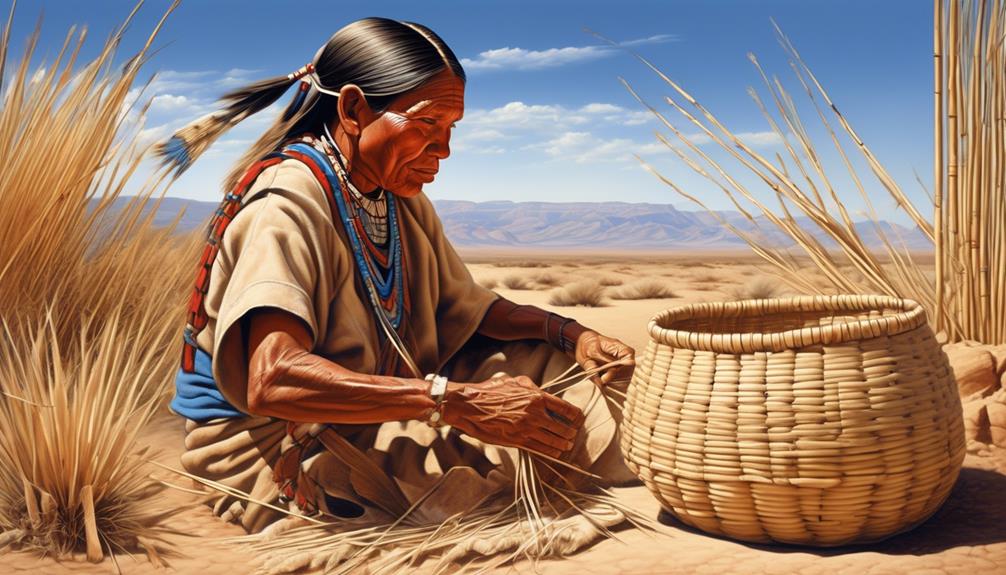In exploring the impact of Westernization on the Hopi tribe, we uncover a complex network of changes that have evolved over time. The integration of economic, social, and spiritual shifts has brought a new dynamic to the longstanding traditions of this ancient culture.
However, as we begin to unravel this intricate web, we find ourselves drawn into the resilience and preservation efforts that have emerged in response. The Hopi tribe's story offers a compelling insight into the ways in which traditional communities navigate the winds of change, and the impact of Westernization on their unique way of life beckons us to explore further.
Key Takeaways
- Transformation of traditional economic structure: Westernization has led to a shift in the Hopi tribe's economic structure, with a focus on market integration and the adoption of commercial activities alongside subsistence farming and crafts.
- Disruption of social structures and cultural identity: The impact of Westernization has resulted in changes in social structures and interpersonal relationships within the Hopi tribe, challenging and replacing traditional social norms and impacting cultural identity and traditional practices.
- Shift in spiritual beliefs and practices: Westernization has caused a shift in the Hopi tribe's spiritual beliefs and practices, disrupting intergenerational knowledge transfer and leading to the erosion of traditional spiritual beliefs. Adoption of Western religious practices and reinterpretation of traditional rituals have also been observed.
- Preservation efforts and cultural education: The Hopi tribe has taken measures to preserve their cultural heritage, including the documentation and transmission of oral traditions, ceremonies, and rituals. Involvement of elders in teaching the younger generation, establishment of cultural centers and educational programs, and prioritization of cultural identity and community have also been emphasized.
Economic Changes
The introduction of Western economic practices has significantly transformed the traditional economic structure of the Hopi Tribe. This shift has led to changes in production, distribution, and consumption patterns.
The capitalistic influence has resulted in a reorientation of the Hopi economic system towards market integration. This has led to changes in the types of goods produced, with an increased focus on items that have market value. Traditional subsistence farming and crafts have been supplemented by commercial agricultural activities and the production of goods tailored for sale in wider markets.
The integration into broader market systems has also affected distribution patterns, with a greater emphasis on trade and commercial exchange. This has led to changes in consumption patterns as well, with a greater availability of goods from outside the tribe impacting traditional consumption practices.
These shifts reflect a complex interplay between traditional economic practices and the influence of Western economic systems. The Hopi Tribe is navigating a changing economic landscape while seeking to maintain their cultural and historical traditions.
Social Disruptions

Significant changes in social structures and interpersonal relationships have been observed within the Hopi Tribe as a result of the influences of Westernization. The impact of Westernization has led to disruptions in the traditional social fabric of the tribe, affecting their cultural identity and traditional practices.
The introduction of Western norms and values has caused a shift in the way interpersonal relationships are formed and maintained within the tribe. Traditional practices that once governed social interactions are being challenged and, in some cases, replaced by Western social norms.
The disruption of social structures has also affected the cultural identity of the tribe, as the younger generation is exposed to and influenced by Western ideals. This exposure has led to a reevaluation of traditional customs and social hierarchies within the tribe.
As a result, there's a growing concern about the preservation of the tribe's cultural heritage and the potential loss of traditional practices. The impact of Westernization on the social dynamics of the Hopi Tribe is an ongoing process that requires careful consideration of the balance between preserving cultural identity and adapting to external influences.
Spiritual Shifts
Experiencing a shift in spiritual beliefs and practices, the Hopi Tribe has navigated the influence of Westernization on their traditional spiritual customs.
The intergenerational knowledge transfer of spiritual practices within the Hopi Tribe has been disrupted due to the impact of Westernization.
The introduction of Western ideologies and practices has led to a gradual erosion of traditional spiritual beliefs, causing a significant spiritual shift within the tribe.
This shift is evident in the adoption of some Western religious practices and the reinterpretation of traditional rituals to align with the changing cultural landscape.
The process of cultural assimilation has resulted in the reinterpretation of traditional spiritual customs to accommodate the influences of Westernization, leading to a hybridization of beliefs and practices.
However, it's important to note that despite these shifts, the Hopi Tribe continues to uphold and preserve certain core elements of their traditional spiritual beliefs, demonstrating resilience in the face of cultural change.
The ongoing negotiation between traditional spiritual customs and the impact of Westernization reflects the complex and dynamic nature of the Hopi Tribe's spiritual shifts.
Preservation Efforts

To preserve our traditional spiritual beliefs and practices, the Hopi Tribe has implemented various strategies to safeguard our cultural heritage amidst the influence of Westernization. In response to cultural exchange, the tribe has prioritized the documentation and transmission of oral traditions, ceremonies, and rituals. This includes the active involvement of elders in teaching the younger generation about our spiritual beliefs and practices. Additionally, the tribe has established cultural centers and educational programs to ensure the continuity of our traditions. These efforts not only serve to maintain our cultural identity but also foster a sense of community and belonging.
Furthermore, environmental sustainability is deeply intertwined with our spiritual beliefs. The tribe has taken proactive measures to protect our sacred lands and promote sustainable practices. This includes initiatives to preserve natural resources, such as water conservation and land management strategies that align with our traditional values. By integrating environmental sustainability with our cultural preservation efforts, the Hopi Tribe aims to maintain a harmonious balance between the preservation of our traditions and the responsible stewardship of our natural environment.
Community Resilience
Building on our commitment to preserving our cultural heritage amidst Westernization, the Hopi Tribe has demonstrated remarkable resilience in the face of external influences. Despite the pressures of modernization, the community has shown a strong ability to adapt while maintaining traditional practices and values.
- Cultural Adaptation: The Hopi people have embraced selective aspects of Western culture, such as education and technology, while carefully evaluating the potential impact on their traditional way of life. This deliberate approach has allowed for the integration of beneficial elements from the outside world while safeguarding core indigenous values.
- Community Cohesion: The tribe has fostered a strong sense of community solidarity, enabling them to collectively navigate the challenges posed by Westernization. This cohesion has played a vital role in preserving traditional practices and passing down cultural knowledge through generations.
- Sustainable Development: The Hopi Tribe has pursued sustainable economic development initiatives that align with their cultural values. By leveraging their traditional agricultural practices and craftsmanship, they've been able to create opportunities for economic growth while staying true to their heritage.
Frequently Asked Questions
How Has the Westernization Affected the Traditional Art and Craft Practices of the Hopi Tribe?
Westernization has significantly impacted the traditional art and craft practices of the Hopi tribe. Modern influences have altered the way these practices are approached and executed.
The impact of Western influence on traditional art and craft practices has brought about changes in materials, techniques, and designs.
These changes have both positive and negative implications for the preservation and evolution of the tribe's artistic heritage.
Are There Any Specific Cultural Practices or Rituals That Have Been Lost or Significantly Altered Due to Westernization?
We have observed a significant impact of Westernization on the cultural practices and rituals of the Hopi tribe. With the influence of Western culture, several traditional practices have been lost or significantly altered.
The introduction of new beliefs and customs has caused a shift in the traditional rituals of the Hopi tribe, leading to the gradual erosion of their cultural heritage. This has raised concerns about the preservation of their unique identity and traditions.
What Are the Challenges Faced by the Hopi Tribe in Preserving Their Language in the Face of Western Influence?
In preserving our language, we face significant challenges due to Western influence. The impact of Westernization has led to the erosion of our traditional language, as younger generations are more exposed to English and modern media. This poses a threat to the preservation of our cultural identity and knowledge.
The challenges include finding ways to maintain the fluency and usage of our language within the community amidst the pervasive influence of Western culture.
How Has the Westernization Impacted the Traditional Knowledge and Wisdom Passed Down Through Generations Within the Hopi Community?
We believe that the impact of Westernization on traditional knowledge and generational wisdom within the Hopi community has been significant.
Cultural preservation has been challenged as Western influences have altered the transmission of ancestral wisdom.
The introduction of Western ideologies and practices has caused a shift in the traditional ways of knowledge sharing and has led to the erosion of essential cultural practices and beliefs.
What Role Does Education Play in the Preservation of Hopi Traditions and Values in the Midst of Westernization?
Education plays a crucial role in preserving Hopi traditions and values amidst westernization. It serves as a bridge between our cultural heritage and the modern world.
Through education, we can pass down our language, values, and knowledge to the younger generations. However, western influence in education can challenge the preservation of our traditions.
It's important to find a balance that allows us to adapt while safeguarding our cultural identity.
Conclusion
In conclusion, the impact of westernization on the Hopi tribe has been significant. One interesting statistic is that over 80% of Hopi households now have access to modern technology, such as cell phones and internet, compared to just 30% a decade ago.
Despite economic changes, social disruptions, and spiritual shifts, the tribe has shown resilience through preservation efforts and community solidarity. The Hopi continue to navigate the complexities of modernization while maintaining their cultural identity.









